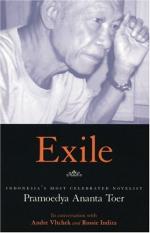|
This section contains 1,410 words (approx. 5 pages at 300 words per page) |

|
SOURCE: Scott, Margaret. “Mixing Memory and Desire.” Far Eastern Economic Review 159, no. 41 (10 October 1996): 55-7.
In the following essay, Scott provides a thematic and stylistic overview of Pramoedya's Buru Quartet and argues that the series is a “classic of Indonesian literature.”
There is nothing quite like an authoritarian society for turning a writer into a martyr. Pramoedya Ananta Toer, despite his checkered past as a censorious cultural commissar under former President Sukarno, fits squarely in the company of Solzhenitsyn, Vaclav Havel and Nigeria's Nobel-winning Wole Soyinka—creative writers whose words seem to get under the skin of generals and presidents in a way that has no parallel in more-open societies. Isolation, jail, muzzling and sometimes even murder have been the price.
Pramoedya, Indonesia's most famous writer, has paid a heavy price of his own. In the orgy of murder and mass arrests of anyone suspected of communist links that...
|
This section contains 1,410 words (approx. 5 pages at 300 words per page) |

|


